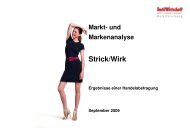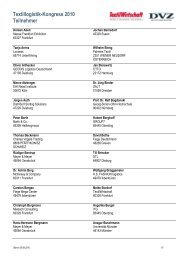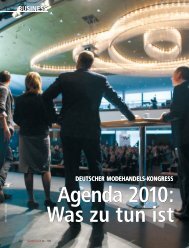UNIQLO Operations - TextilWirtschaft
UNIQLO Operations - TextilWirtschaft
UNIQLO Operations - TextilWirtschaft
You also want an ePaper? Increase the reach of your titles
YUMPU automatically turns print PDFs into web optimized ePapers that Google loves.
<strong>UNIQLO</strong>’s Business Model<br />
<strong>UNIQLO</strong> is an SPA (Specialty Store Retailer of Private Label Apparel), meaning its activities are fully integrated from<br />
design through production and retailing. To offer high-quality products at low prices, <strong>UNIQLO</strong>, backed by its sales<br />
network of approximately 790 stores worldwide, controls all stages of the supply process—from product design to<br />
the procurement of materials, quality control, inventory adjustments, and other aspects—and insists on low-cost<br />
management. In addition, <strong>UNIQLO</strong> takes 100% of the raw materials and inventory risks. This is exactly the reason<br />
why <strong>UNIQLO</strong> can differentiate itself from competitors and generate profits.<br />
16<br />
Store Development and Design<br />
The store development and design team<br />
conducts simulations of sales and profitability<br />
and decides on store locations.<br />
Stores are designed to suit various retail<br />
venues and floor space.<br />
Men’s<br />
FAST RETAILING ANNUAL REPORT 2007<br />
Head Office<br />
The merchandising, R&D, and marketing<br />
departments work together to prepare<br />
numerical plans, develop product mixes<br />
to match the concept for the season,<br />
and adjust production according to sales<br />
volume.<br />
Product Planning (Merchandising) and Marketing (Promotion)<br />
Women’s<br />
Kids’<br />
R&D Center<br />
<strong>UNIQLO</strong>’s R&D Center has operations in Tokyo, New York, Paris, and Milan and researches world trends in fashion and lifestyles.<br />
Based on this information, concepts for each season are decided at meetings held jointly with representatives of <strong>UNIQLO</strong>’s<br />
merchandising and marketing departments. Based on these concepts, the R&D Center creates designs simultaneously in these<br />
four cities, then makes its selection of products from samples to structure and arranges product lineups for individual countries.<br />
Research<br />
R&D Center<br />
Concept Creation Design Coordination<br />
Sales Planning and Production Inventory Control<br />
Accessories<br />
Sales<br />
Inner wear<br />
Based on the concept for the season, sales plans and product mixes are prepared by<br />
product categories (men’s, women’s, kids’, accessories, and inner wear). The marketing<br />
department then advertises campaign products using flyers and TV commercials.<br />
The inventory control team, working with<br />
the merchandising, sales, and production<br />
departments, monitors sales activity and<br />
inventory levels to minimize inventory risk.<br />
Materials Planning and Procurement<br />
The materials planning team negotiates<br />
directly with leading materials manufacturers<br />
and procures top-quality materials<br />
from around the world. In addition, in<br />
cooperation with materials manufacturers,<br />
the team works to develop new fabrics.<br />
<strong>UNIQLO</strong> calls on about 70 partner factories<br />
located in China and the rest of Asia for production<br />
and provides them with proactive<br />
technological support. <strong>UNIQLO</strong> has formed a<br />
team of specialists called takumis, each with<br />
experience of 30 years or more in Japan’s textile<br />
industry who are seconded to these factories.<br />
The takumis are closely involved in all<br />
aspects of the production processes from<br />
inspection of yarn to the shipment of final<br />
goods, and they keep a sharp eye on a wide<br />
range of things, including materials and yarn,<br />
weave patterns, dyeing, sewing, texture, finish,<br />
and safety issues.<br />
<strong>UNIQLO</strong>’s products are manufactured in<br />
large lots of about one million at partner factories.<br />
To ensure level quality for such a large<br />
volume of products, problem-solving capabilities<br />
backed by experience are indispensable.<br />
That is where the skills of the takumis are<br />
making a major contribution. For example, in<br />
the dyeing process, to ensure that colors produced<br />
by tens of vats of dye, with a capacity<br />
of one ton each, are uniform, tasks do not<br />
stop at the confirmation of the process but<br />
must also extend to checking on the humidity<br />
and setting conditions accurately.<br />
At present, about 90% of <strong>UNIQLO</strong> products<br />
are manufactured in China. As <strong>UNIQLO</strong>’s retail<br />
network is extended around the world, the<br />
production network is being extended to other<br />
countries in Asia, including Vietnam. Going<br />
forward, <strong>UNIQLO</strong> will insist on quality<br />
management in its world-class manufacturing<br />
systems.<br />
(Photographs: partner factories.)<br />
Quality and Production<br />
Controls<br />
At <strong>UNIQLO</strong>’s Shanghai office,<br />
about 120 members of staff are<br />
responsible for quality and<br />
production supervision. They<br />
maintain close contact between<br />
the partner factories and the<br />
<strong>UNIQLO</strong> Head Office to confirm<br />
progress toward the completion<br />
of production runs as well as<br />
identifying and solving problems.<br />
The staff visits partner factories<br />
three to four days each week to<br />
conduct quality and safety<br />
checks and confirm manufacturing<br />
specifications. As a result of<br />
these initiatives, <strong>UNIQLO</strong> aims to<br />
make improvements in product<br />
quality and production process<br />
yields.<br />
* For more about quality and safety control, please see page 39.<br />
Spinning<br />
The spinning begins with the unraveling of raw<br />
yarn materials. To ensure stable quality, cotton<br />
from several areas is blended.<br />
More than 10,000 cones for winding yarn must<br />
have the same degree of tension to ensure that<br />
yarn production is uniform.<br />
At weekly reporting sessions, <strong>UNIQLO</strong> staff identifies problems<br />
related to materials and issues arising in the sewing and processing<br />
stages, and supervisors confirm the deadlines for taking<br />
action to address these issues.<br />
Weaving<br />
Although weaving processes are automated,<br />
texture and quality are measured and assessed<br />
by experienced masters.<br />
Plant personnel check for flaws in the woven<br />
cloth using a translucent light board.<br />
FAST RETAILING ANNUAL REPORT 2007 17<br />
Production<br />
Shintaro Shiba, Production Control<br />
<strong>UNIQLO</strong> representatives conduct intense<br />
discussions with production partners to<br />
maintain quality.<br />
Dyeing<br />
Strips of cloth joined together are dyed as they<br />
pass through the liquid flow dyeing machine.<br />
Dyeing solutions prepared by computer are<br />
adjusted through artisans’ eyes to detect subtle<br />
shades.<br />
<strong>UNIQLO</strong>’s Takumi Team<br />
Since 2000, <strong>UNIQLO</strong>’s takumi<br />
team, comprising veteran personnel<br />
trained and seasoned in<br />
Japan’s textile industry, plays a<br />
substantive role in providing<br />
technical support to partner<br />
factories. These takumis have a<br />
diverse range of backgrounds<br />
and skills, and each of them<br />
plays a role in supporting the<br />
quality of <strong>UNIQLO</strong> products<br />
while transmitting his knowledge<br />
gained in Japan’s once<br />
highly acclaimed apparel industry<br />
to the next generations.<br />
Processing<br />
Gradations and detailed patterns are finished by<br />
hand carefully to create a beautiful finished product.<br />
Large-scale equipment finishes multi-color prints<br />
flawlessly and is capable of processing large lots.<br />
Tadamichi Tokuoka<br />
“The basics are extremely<br />
important in nurturing craftsmanship.<br />
There are still many<br />
things that even I do not know.”<br />
A specialist in dyeing woven<br />
materials, Tokuoka worked as a<br />
dyer for more than 40 years,<br />
matching colors and performing<br />
finishing in the textile industry.<br />
Michio Ota<br />
“Becoming friends and talking<br />
to them on the same level are<br />
essential. Another essential is to<br />
show successful cases as fast<br />
as you can.”<br />
Ota is a takumi specializing in<br />
quality control. He has worked<br />
in the dyeing field since the<br />
1950s, when Kyoto’s dyeing<br />
industry was at its height.<br />
Sewing and Finishing<br />
The sewing process begins with cutting and<br />
machine sewing. Sewing requires attention to<br />
detail and patience.<br />
Ironing and packing are performed with great<br />
care. Quality and safety inspections are conducted<br />
several times.<br />
Hidenori Konishi<br />
I can see our processes getting<br />
better and better right before my<br />
eyes. Nothing could make me<br />
happier!”<br />
In charge of the sewing processes,<br />
from cutting to inspection,<br />
Konishi has earned a reputation<br />
for technical guidance with an<br />
eye for detail.<br />
FAST RETAILING ANNUAL REPORT 2007 18













